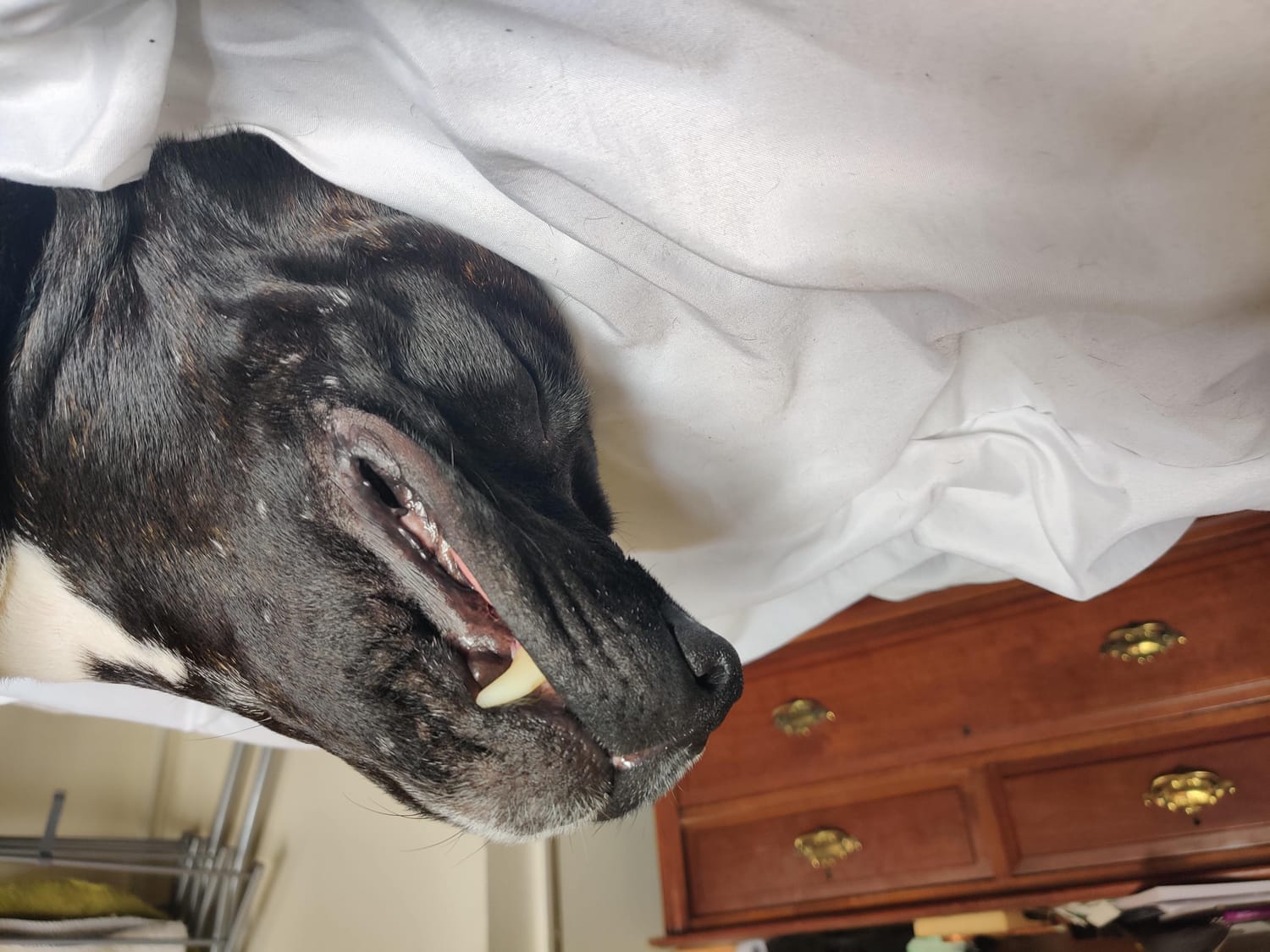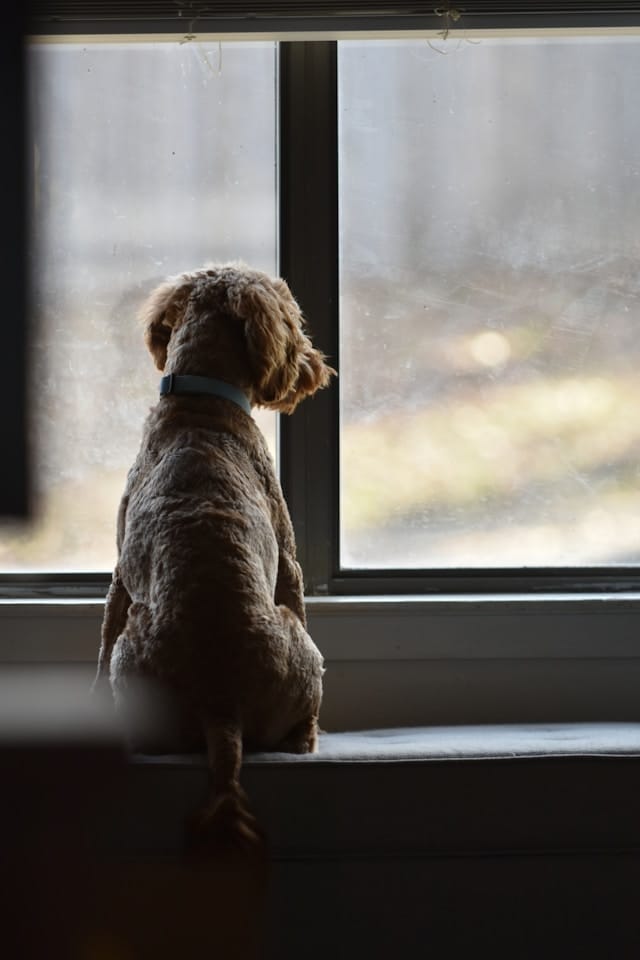Structure vs. Control: Creating Safe Routines for Dysregulated Dogs
If you’re living with a reactive or dysregulated dog, you’ve probably been told they need more structure. But what kind? What does that actually mean? Is it about laying down stricter rules, tighter leashes, more obedience, “leave its” or “no’s?"
Structure for dysregulated dogs isn’t about control — it’s about creating clarity and safe, predictable rhythms/routines that help them relax and regulate. It’s the difference between micromanaging your dog’s every move…and helping them move through their day in a way that supports them and their nervous system.
In this post, I'm going to explore the difference between structure and control, why structure matters so much for reactive dogs, and how to create daily routines that support calm, confidence, and better choices.

Structure vs. Control: What’s the Difference?
It’s easy to confuse structure with control — but the two feel completely different to your dog though.
Structure is about predictability, rhythm, and gently guiding your dog through their day in a way that makes sense to their brain.
Control is about micromanaging. It’s corrections over communication, rigidity over engagement and relationship.
Have you ever been in a job (or relationship) where you were constantly micromanaged?
Constantly told every small thing you're doing wrong. Feeling like your being nagged to do things that you were going to do. Feeling like you don't have a chance to prove yourself...
How did that make you feel? How did that go on to affecting your work/relationship, or even your mood? It's exhausting isn't it. Maybe even slightly frustrating. Maybe even enough for you to stop caring about it all together right?
So why is it different to our own dogs?
Let’s break it down:
Structure says: “This is what happens next.”
Control says: “Do this now, or else.”
Structure offers: Routine, cues, patterns, regulated energy
Control creates: Tension, resistance, shutdowns, blow-ups
You might have already noticed this, but if your dog already struggles to regulate their emotions, internal state or environment, piling on more control often makes things worse, even if you're doing it with good intentions. But structure? Structure creates space for their nervous system to settle.
Why Dysregulated Dogs Need Structure (Not Control)
Dogs who are chronically stressed, overstimulated, or reactive live in a state of high alert. Their bodies don’t feel safe, even if their environment is safe.
For dogs like this, structure is a lifeline that helps:
Lower arousal levels by adding predictability to their day
Reinforce safety and better habits through consistent patterns
Reduce the mental load of decision-making (decision-fatigue)
Supports and creates regulation between dog and human
🧠 Paws of Wisdom’s Regulation Roadmap
This post fits into Phase 1: Detox of my Regulation Roadmap — the starting point for dogs who are constantly overstimulated, overaroused, or “on edge.”
This is where dysregulated dogs and burned-out owners start building the calm, clarity, and capacity needed for real change.
Signs You Might Be Leaning Into Control (And It’s Backfiring)
It’s not always obvious when we’ve slipped from structure into control. Some common signs:
Correcting behaviours more than guiding them
Giving rapid-fire commands with no decompression
Tension on the leash at all times
Relying on “no,” “leave it,” or “uh uh” instead of clear cues
Your dog resists you, shuts down, or explodes without warning
There was a point in my journey with Jasper where I ended up pushing more into control-territory and I just wanted to share so you know how easy it can actually be. Looking back on it, it was so obvious but when you are dysregulated and frustrated, you don't think clearly...
So this period of time was when reactivity was through the roof, and I genuinely believed the solution was more training, more structure…and by structure, I mean control.
Walks became rigid. There was no liberty, no chance to just be a dog. Every moment was micromanaged. I relied heavily on cues and pressure, got frustrated when he “wouldn’t listen,” and felt like I had to stay one step ahead of every meltdown.
But the truth was Jasper wasn’t being difficult — he was dysregulated. His nervous system couldn’t meet my expectations, no matter what I threw at him, and the more I threw at him (no matter how good intentioned) just failed to land.
It wasn’t until we ended going through a proper detox that I realised how much control I was clinging to…and how much calmer things got when I let go of that grip.
I didn’t need perfect. I just needed better.
What Jasper needed was not more pressure, but more clarity, predictability, and support.That’s when control turned into structure. Not a tightrope to walk, but a rhythm to follow. Something that let him know what was coming, gave him space to make choices, and helped him actually want to work with me.
Structure became the safety net. Not a set of rules to obey, but a framework we could both rely on and fall into.

What Supportive Structure Actually Looks Like
Now we know what structure isn't, let’s switch gears and talk about what structure should look like for dysregulated dogs.
Here are a few foundational practices to help shift you from control to clarity:
#1 - Predictable Routines
Wake, walk, meals, enrichment, rest — keep these big events in the same order, every day
Use consistent cues: “All done”, “This way"
Avoid chaotic transitions (like suddenly rushing to the door or through thresholds)
#2 - Calm Thresholds & Transitions
Practice calm at the door, before walks, before crate exits
Using place training to create relaxation
Use and encourage natural pauses — not harsh commands — to encourage thinking
Don’t hype them up before asking for stillness (provide decompression if needed)

#3 - Freedom Within Boundaries
Use x-pens, baby gates, and provide safe havens to give options
Try “invitation” instead of “instruction” (e.g., “Want to rest here?” vs “Go lie down”)
Offer choices when you can (toy A or B? rest in crate or on mat?)
#4 - Decompression First, Training Later
Walks aren’t just about exercise — they’re nervous system resets
Don't push training if your dog is already dysregulated
Prioritise sniffing, enirchment, outlets, calm connection, and post-walk decompression
The Rhythm of the Day: Opening Behavioural “Windows” for Your Dog
(inspired by the work of Jay Jack)
If you’re living with a dysregulated or reactive dog, you already know the chaos that can creep in when there’s no rhythm to the day...
You wake up, your dog’s already wired. You try to do training — but they can’t focus. You try to chill — but they’re pacing. It all feels scrambled and chaotic...like everyone’s playing different instruments, but no one’s in tune.
That’s where something called “windows of opportunity” comes in. It’s a concept I first heard from Jay Jack, and it helped me reframe the way I structure Jasper’s day — not around rigid control, but around intentional rhythm.
Think of it like this:
You’re the one who opens the windows.
Each window represents a "mode of being" — play, rest, work, freedom/explore.
You open a window on purpose, give your dog the chance to meet that moment, then gently close it when it’s time to shift gears into the next window.

The goal?
Help your dog learn when it’s time to go full goblin — and when it’s time to switch off. Not through commands but through repetition, consistency, and emotional cues in the environment.
Let's get into the four windows...
The Play Window
This is your full-send, high-energy, mutual mayhem mode.
Tug, chase, flirt pole, wrestling. It’s not just physical — it’s social and co-regulated. You’re part of the game. You invite them in. You help them come back down.
The Work Window
Now even though I have swayed from relying on obedience (before foundations), this would be where your cues live.
It’s not just about “obedience” — it’s about clarity. You ask for something. They do the thing. You mark the end. It’s a focused, purposeful container. This window is small, and it closes quickly for dysregulated dogs.
The Rest Window
This is when the whole house slows down. Lights dim. Sound softens. You decompress together.
No cues, no expectations, just calm energy and safety. If your dog can’t access this window easily, that’s your sign to go back to basics.
The Freedom Window
This one is all about choice. Sniffing, chewing, digging, sunbathing. They lead the way, without your involvement.
You simply make sure the space is safe and the options are rich and in reach. This is where agency and trust is born.
Dogs don’t just know what window they’re in. You teach them, over time, by clearly opening and closing each one with intention — and not blending them all together into one big overstimulated mess.
When every moment of the day is a free-for-all, your dog stays stuck in reaction mode. When every moment is command-heavy, they burn out and push back.
But when you start to build that rhythm — opening play when it’s time for play, guiding into rest when it’s time to rest — something starts to slowly shift.
You and your dog start moving together. They begin to relax into the pattern. Their body learns when it can explode, when it can unwind, and when it’s safe to just be.
This is what structure really means.
Not control. Not perfection.
But rhythm. Intention. Harmony. Partnership.
How Structure Can Transform Daily Life
When you shift from control to structure, everything starts to feel so much damn lighter.
You might notice:
Fewer explosions, tantrums or meltdowns
Your dog relaxes into daily rhythms with less anxiety
Walks feel smoother, even if not “perfect”
You spend less time managing and more time connecting
We aren't looking for perfect obedience, but better regulation, day by day.
TL;DR: Structure for Dysregulated Dogs Cheat Sheet
✅ Structure = rhythm, cues, routine
❌ Control = correction, tension, micromanaging
🧠 Dysregulated dogs need predictability, not pressure
🛠 Use routines, threshold pauses, calm choices
📉 Focus on decompression over discipline
Want to See What’s Working? Track It...
Shifting from control to structure isn’t something that changes your dog overnight — but the signs start small: a calmer exit from the crate, fewer outbursts on walks, more willingness to settle.
But here’s the thing…those changes are easy to miss if you’re not looking for them. Especially when the day-to-day still feels a bit messy.
That’s where my Digital Dog Training Journal comes in.
Use it to:
Track how changes in your structure or routine affect your dog’s behaviour
Notice patterns between dysregulation, unmet needs, and certain times of day
Celebrate small wins that might otherwise slip through the cracks
Adjust your approach with more clarity and less second-guessing
Structure isn’t a set-it-and-forget-it plan. It’s a rhythm you refine over time — and the journal helps you actually see what’s helping and what’s not (read more about tracking your dog's progress here).
👉🏾 [Grab your journal here] and make the invisible progress visible...
Final Thoughts: Ready to Rebuild Your Rhythm?
You don’t need to overhaul your whole life overnight. Creating structure for dysregulated dogs starts with one calm cue, one predictable routine, one supportive shift.
That’s why I created the Paws Of Wisdom Detox Protocol — to help reactive and overwhelmed dogs reset with calm, clarity, and confidence.
It’s the first step in the Regulation Roadmap, and the perfect foundation for building better structure without falling into the control trap.
👉🏾 [Click here] to learn more about the Paws Of Wisdom Detox Protocol
…and start building a rhythm your dog can finally relax into.
Frequently Asked Questions (FAQs): Structure & Emotional Regulation for Dogs
Start by focusing on rest, decompression, and low-stress routines. Once your dog’s nervous system is more balanced and regulation starts coming more naturally, you can build in impulse control games and calm engagement.
Shift the focus from fixing the reaction to supporting the emotion underneath it. The build up before it.
Help your dog feel safe, regulated, and understood — and behaviour change will follow.
Absolutely. Structure gives dogs predictability, which helps them feel safe, understand what is expected, and make better choices — especially when they struggle with reactivity or dysregulation.
Use consistent routines, predictable transitions, and time blocks for rest, play, and engagement. Think rhythm, not rigidity — your dog thrives on knowing what to expect.
Boundaries aren’t about control — they’re about clarity. Calmly guide your dog on what’s okay and what’s not, and hold those lines with kindness and consistency.
Related Reading
A FREE community with downloadable guides and resources, and people who get it.
A simple and structured reset for overstimulated, dysregulated, chaotic dogs.
Simple, clear guidance to help you understand your dog through a regulation-first lens.










